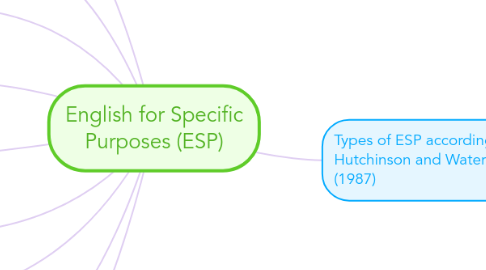
1. Learner must already have basic knowldege of English (e.g. intermediate or adavnced learners.
2. It's designed for specific disciplines or occupations
3. It's mainly for adult learners
4. It's not linked to any particular methodology
5. It may or may not be restricted to any particular language skill.
6. An ESP course may have a broad reach.
7. Teacher prepares syllabus to meet students' specific needs
8. ESP courses do not use general English books. Instead materials are specific to a certain specialization.
9. Materials must be authentic and content must be context-based.
10. Types of ESP according to Hutchinson and Waters (1987)
10.1. English for Science and Technology (EST)
10.1.1. English for Occupational Purposes (EOP) also known as English for Vocational Purposes (EVP) and Vocational English as a Second Language (VESL)
10.1.1.1. English for Technicians
10.1.1.2. English for Technical Manuals
10.1.2. English for Academic Purposes (EAP)
10.1.2.1. English for Medical Studies
10.1.2.2. English for Software Engineers
10.2. English for Business and Economics (EBE)
10.2.1. English for Occupational Purposes (EOP) also known as English for Vocational Purposes (EVP) and Vocational English as a Second Language (VESL)
10.2.1.1. English for Secretaries
10.2.1.2. English for Cashiers
10.2.2. English for Academic Purposes (EAP)
10.2.2.1. English for Economics
10.2.2.2. English for Accountants
10.3. English for Social Sciences (ESS)
10.3.1. English for Occupational Purposes (EOP) also known as English for Vocational Purposes (EVP) and Vocational English as a Second Language (VESL)
10.3.1.1. English for Psychology
10.3.1.2. English for Political Science
10.3.2. English for Academic Purposes (EAP)
10.3.2.1. English for Teaching
10.3.2.2. English for Presentations
